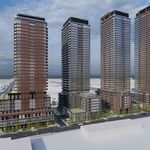zang
Senior Member
SMRs—at least the rector itself—can be as small as a shipping container. It’s often the support buildings that take up the most space. There’s no reason the reactor couldn’t be built underground with support buildings above on an area the size of a football pitch. Doable for just about any neighbourhood in the city.
And yes, while none that I know of have gone into mass production, there are plenty of SMRs around the world in testing or currently under construction, including here in Ontario. As of last year, several manufacturers were nearing the finish line for deployment:
Also, please inform me on what’s wrong with my argument about using storm water storage for hydroelectric. I’m curious as to why you seem so willing to laugh at the idea. If one can purchase a micro hydroelectric generator for a stream on the family farm, it hardly seems implausible for storm water system, does it?
And yes, while none that I know of have gone into mass production, there are plenty of SMRs around the world in testing or currently under construction, including here in Ontario. As of last year, several manufacturers were nearing the finish line for deployment:
Also, please inform me on what’s wrong with my argument about using storm water storage for hydroelectric. I’m curious as to why you seem so willing to laugh at the idea. If one can purchase a micro hydroelectric generator for a stream on the family farm, it hardly seems implausible for storm water system, does it?




